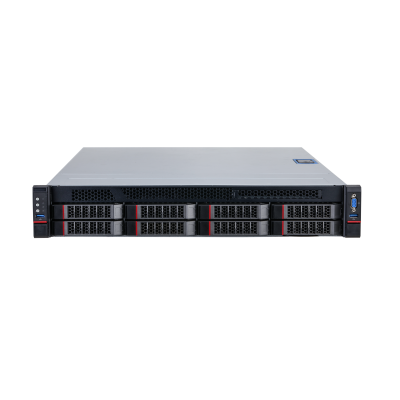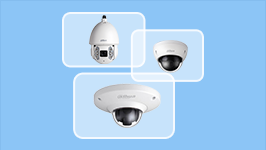IVS-IP8000-xE-GU2

Event Detection Intelligent Server
> Dynamic loading of algorithm and chip separation to enhance system robustness.
> Universal server with PCIE slot design that enables recycling old servers to reduce costs.
> Based on video cloud architecture, it supports standalone and clustered deployment that satisfies various requirements for capacity expansion.
> The server can be sold with a client or separately, and it can work with third-party devices.
> Supports tripwire, intrusion, climbing, getting up, stay, sleep, abnormal number of people, abnormal sound, fight, staying alone, crowd gathering, object detection, calling, using mobile phone, falling, fast running, smoking, covering head while sleeping, hitting body, clothes detection, and video quality diagnosis.

System
Main Processor
Two 10 cores/20 thread X86 processors, 2.2 GHz
Chip
Intel C236
Operating System
CentOS Linux release 7.4.1708 (Core)
Intelligent Analysis Card
Six AIX3200 intelligent analysis cards
Memory
Four 16 GB DDR4 memory modules with up to 24 slots
Disk
Two 3.5"4 TB HDD which can be expanded to maximum 32 TB (each HDD is 4T) with up to 8 slots.
7.2K RPM SATA 6 Gbps 512n 3.5"RAID
RAID 0/1
Event Detection in Controlled Place
Tripwire Detection
1. Set the detection line as a polyline with an arbitrary shape. (Note: Dahua protocol defines that the line has maximum 20 points).
2. Specify the direction of illegal crossing for each detection line (unidirectional or bidirectional).
3. Set up to 10 independent detection lines for each scenario (configure 10 intelligent rules).
4. Set the target trigger position (the upper, lower, left and right sides and center point of the target box). It is set as the center point by default.
5. Set the arming period from Monday to Sunday with up to 6 arming periods for each day.
6. An alarm is triggered when a target crosses the detection line.
7. The system recognizes the attributes of police uniforms. You can enable intelligent configuration and notifications of alarms on the client. It also supports target attribute filtering, and this function is disabled by default.Intrusion Detection
1. Set the detection area as a polygon with an arbitrary shape (note: Dahua protocol defines that a polygon has maximum 20 edges).
2. Set up to 10 independent detection areas for each scenario.
3. For each detection area, behavior detection can be set as crossing the area, inside the area or both.
4. For inside the area detection, the number of targets, minimum duration, and report interval can be set. Minimum duration: 1 s–600 s; report interval: 0 s–600 s.
5. For targets crossing the area, the crossing direction can be set as entry, exit, or entry and exit.
6. Set the arming period from Monday to Sunday with up to 6 arming periods for each day.
7. An alarm is triggered when a target enters or exits the detection area.
8. The system recognizes the attributes of police uniforms. You can enable intelligent configuration and notifications of alarms on the client. It also supports target attribute filtering, and this function is disabled by default.Climbing Detection
1. Set the detection line as a polyline with an arbitrary shape (note: Dahua protocol defines that the line has maximum 20 points).
2. Set up to 10 independent detection lines for each scenario.
3. An alarm is triggered when any part of the body below the head crosses the height detection line.
4. Set the arming period from Monday to Sunday with up to 6 arming periods for each day.Getting up Detection
1. Set a rectangular area for detecting getting up behavior.
2. Set the alarm trigger line and sleep direction line (from head to feet) for each detection area.
3. Set up to 10 independent detection areas for each scenario.
4. Scenario requirement: The bed should be perpendicular to the monitoring direction of the camera.
5. Only supports single-layer beds. Bunk beds are not supported at this time.
6. An alarm is triggered when the target gets up during arming.
7. Set the arming period from Monday to Sunday with up to 6 arming periods for each day.Staying (Loitering) Detection
1. Set the detection area as a polygon with an arbitrary shape (note: Dahua protocol defines that a polygon has maximum 20 edges).
2. Set up to 10 independent detection areas for each scenario.
3. Set the minimum duration and report interval. Minimum duration: 1 s–600 s; report interval: 0 s–600 s.
4. An alarm is triggered when the stay (loitering) duration exceeds the defined time in the specified area.
5. Set the arming period from Monday to Sunday with up to 6 arming periods for each day.Sleeping Detection
1. Set the detection area as a polygon with an arbitrary shape (note: Dahua protocol defines that a polygon has maximum 20 edges).
2. Set up to 10 independent detection areas for each scenario.
3. Set the minimum duration and report interval. Minimum alarm duration: 1 s–3,600 s; report interval: 0 s–3,600 s.
4. An alarm is triggered when an on-duty personnel stays still or lies down on a table for longer than the defined period.
5. Set the arming period from Monday to Sunday with up to 6 arming periods for each day.Abnormal Number of People Detection
1. Set the detection area as a polygon with an arbitrary shape (note: Dahua protocol defines that a polygon has maximum 20 edges).
2. Set up to 10 independent detection areas for each scenario.
3. Set the minimum duration and report interval. Minimum duration: 1 s–60 s; report interval: 0 s–300 s.
4. Configure detection modes to: 1. Report when people number is equal to, not equal to, greater than or less than the threshold. 2. Report when people number is within the range (including the boundary value) or falls outside the range (excluding the boundary value). 3. Report on the number of people in an area in real-time.
5. When the detection mode is reported with the real-time people number in the area, the real-time people number will appear on the left side.
6. Set the arming period from Monday to Sunday with up to 6 arming periods for each day.Abnormal Sound Detection
1. After configuring the rule, the client displays the decibel value of the sound intensity on the video channel in real-time.
2. Set the decibel value threshold and the duration for triggering alarms.
3. When the decibel value exceeds the defined value (1 dB-150 dB) and lasts longer than the minimum duration (0 s-30 s), an alarm is triggered (one channel only supports one detection rule).
4. Set the arming period from Monday to Sunday with up to 6 arming periods for each day.Fight Detection
1. Set the detection area as a polygon with an arbitrary shape (you can only set one detection area and one fight rule per video channel) (note: Dahua protocol defines that a polygon has maximum 20 edges).
2. Supports 16-channel fight detection analysis (overlaid analysis of fight detection and other rules).
3. Set the arming period from Monday to Sunday with up to 6 arming periods for each day.
4. Set detection sensitivity from 1 to 10.Staying Alone Detection
1. Set the detection area as a polygon with an arbitrary shape (note: Dahua protocol defines that a polygon has maximum 20 edges).
2. Set up to 10 independent detection areas for each scenario.
3. When the target stays alone in the detection area, an alarm is triggered.
4. Set the minimum duration and report interval. Minimum duration: 1 s–1,200 s; report interval: 0 s–600 s.
5. Set the arming period from Monday to Sunday with up to 6 arming periods for each day.Crowd Gathering
1. An alarm is triggered when the duration of crowd gathering in the detection area exceeds the defined time.
2. Set the detection area as a polygon with an arbitrary shape.
3. Set the sensitivity level from 1 to 10.Object Detection
1. When there is an abandoned object or a missing object in detection area, an alarm is triggered.
2. Set up to 4 independent detection areas for each scenario and set the minimum alarm duration and report interval.
3 Event information includes event time, channel, alarm type, rule name, rule line, scenario picture, and object box.
4. Set the detection area as a polygon with an arbitrary shape.
5. Set the minimum alarm duration from 6 s to 3,600 s.
6. Set the arming period from Monday to Sunday with up to 6 arming periods for each day.Calling Detection
1. When the call lasts longer than the defined time in the detection area, an alarm is triggered.
2. Set the detection area as a polygon with an arbitrary shape.
3. Set the arming period from Monday to Sunday with up to 6 arming periods for each day.
4. Set the sensitivity level from 1 to 10. It is 5 by default.
5. Set the minimum duration and report interval. Minimum duration: 1 s-600 s (10 s by default); report interval: 0 s-600 s (0 s by default).
6. Event information includes event time, channel, alarm type, rule name, and scenario picture.
7. View the alarms in real-time on the client.Using Mobile Phone
1. When the target uses the phone for longer than the defined time, an alarm is triggered.
2. Set the detection area as a polygon with an arbitrary shape.
3. Set the arming period from Monday to Sunday with up to 6 arming periods for each day.
4. Set the sensitivity level from 1 to 10. It is 5 by default.
5. Set the minimum duration and report interval. Minimum duration: 1 s–600 s (10 s by default); report interval: 0 s-600 s (0 s by default).
6. Event information includes event time, channel, alarm type, rule name, and scenario picture.
7. View the alarms in real-time on the client.Fall Detection
1. Detects squatting and falling. Fall detection and squat detection are enabled by default. Squat detection can be disabled.
2. Set the detection area as a polygon with an arbitrary shape.
3. Set the arming period from Monday to Sunday with up to 6 arming periods for each day.
4. Set the sensitivity level from 1 to 10. It is 5 by default.
5. Set the minimum duration and report interval. Minimum duration: 1 s-600 s (3 s by default); report interval: 0 s-600 s (0 s by default).
6. Event information includes event time, channel, alarm type, rule name, and scenario picture.
7. View the alarms in real-time on the client.Running Detection
1. Set the detection area as a polygon with an arbitrary shape.
2. Set up to 10 independent detection areas for each scenario.
3. Set the arming period from Monday to Sunday with up to 6 arming periods for each day.
4. Set the sensitivity level from 1 to 10. It is 5 by default.
5. Event information includes event time, channel, alarm type, rule name, and scenario picture.
6. View the alarms in real-time on the client.Smoking Detection
1. When the target smokes in the detection area for longer than the defined time, an alarm is triggered.
2. Set the detection area as a polygon with an arbitrary shape.
3. Set the arming period from Monday to Sunday with up to 6 arming periods for each day.
4. Set the sensitivity level from 1 to 10. It is 5 by default.
5. Set the minimum duration and report interval. Minimum duration: 1 s-600 s (30 s by default); report interval: 0 s-600 s (0 s by default).
6. Event information includes event time, channel, alarm type, rule name, and scenario picture.
7. View the alarms in real-time on the client.Sleeping with Quilt Covering Head
1. Set the detection area as a polygon with an arbitrary shape (note: Dahua protocol defines that a polygon has maximum 20 edges).
2. Set up to 10 independent detection areas for each scenario.
3. When the target is detected sleeping with quilt covering head, an alarm is triggered.
4. Set the arming period from Monday to Sunday with up to 6 arming periods for each day.
5. Set the minimum duration and report interval. Minimum duration: 1 s-600 s (10 s by default); report interval: 0 s-600 s (0 s by default).Posture Detection (Banging Head on Wall)
1. Set the detection area as a polygon with an arbitrary shape (note: Dahua protocol defines that a polygon has maximum 20 edges).
2. Set up to 10 independent detection areas for one scenario.
3. When a target is detected banging their head on a wall or they run into a wall and bang their head on it, an alarm is triggered. Set the minimum duration and report interval. Minimum duration: 1 s-600 s (5 s by default); report interval: 0 s-600 s (0 s by default).
4. Set the arming period from Monday to Sunday with up to 6 arming periods for each day.Video Quality Diagnosis
1. Diagnose the quality of videos and set the duration of the analysis for each channel. Analysis durations is from 25 s-60 s. It is 30 s by default. Only global configuration is supported: All channels share the same configuration.
2. Enable or disable AI analysis. If it is enabled, the system analyzes one channel at a time.
3. Set alarm threshold.
4. Diagnose video loss, image high-brightness, image low-brightness, image color cast, image blurring, B/W image, video jitter, image freeze, video tampering and video scene change.
5. Event information includes event time, channel, alarm type, rule name, and scenario picture.
6. View the alarms in real-time on the client.Performance of Event Detection in Controlled Place
Camera Access
Provide access to and perform analysis on the camera. A single server supports up to 32*x channels of 1080p cameras at the same time.
Application of Event Detection in Controlled Place
Scenario Type
It is widely applicable to indoor scenarios such as prisons and detention centers.
Camera Installation Method
Inclined mount
Camera Installation Height
3 m–5 m (9.84 ft–16.40 ft)
Camera Installation Angle
Inclined mount
Resolution
Above 720p
Port
Network Port
2 × 1,000M/10,000M Ethernet ports
USB
2 × front USB 2.0 ports, 3 × rear USB 3.0 ports
VGA
2
Others
1
DP
2
General
Power Supply
100–127 V/200-240 V, 50–60 Hz, 10 A/5 A
Power Redundancy
Dual power supply
Power Consumption
≤ 800 W
Operating Temperature
10 °C to +35 °C (50 °F to +95 °F)
Operating Humidity
35 °C–80 °C (RH), max. 90% (RH)(+40 °C/+104 °F)
Storage Temperature
–40 °C to +60 °C (–40 °F to +140 °F)
Storage Humidity
20%–93% (RH)
Gross Weight
35.00 kg (77.16 lb)
Net Weight
27.50 kg (60.63 lb)
Product Dimensions
87 mm × 438 mm × 735 mm (3.43" × 17.24" × 28.94") (H × W × D)
Packaging Dimensions
273 mm × 754 mm × 1069 mm (10.75" × 29.69" × 42.09") (H × W × D)
Installation
Standard 19" rack installation with guide rail


















